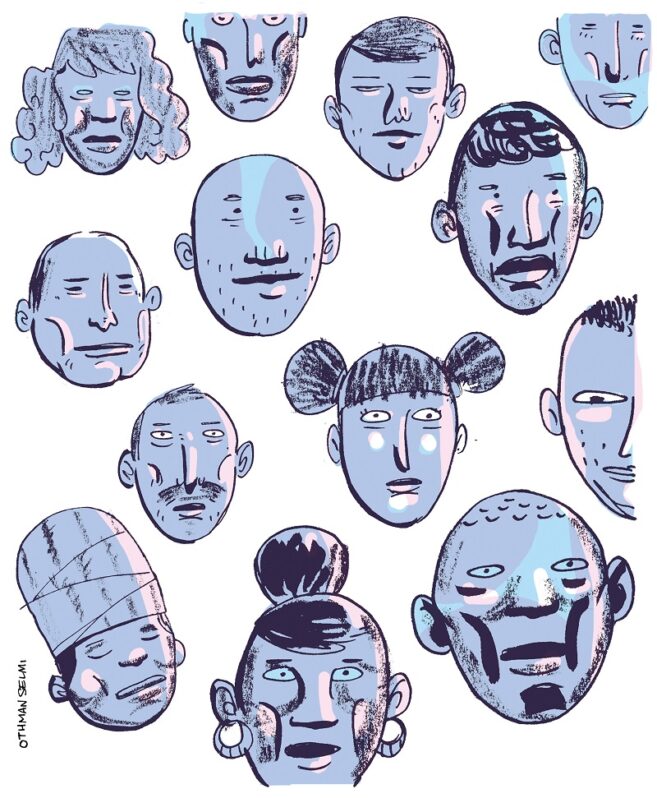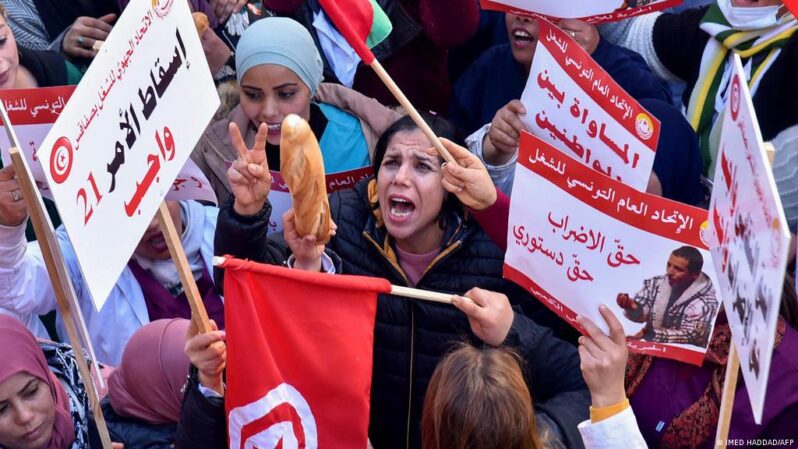Tunisia’s Jemna Experiment: A Century-Long Journey to Reclaim the Land

On 12 January 2011, as the streets of most Tunisian cities were revolting against the rule of President Zine El Abidine Ben Ali and the protests were first reaching Le Passage in the heart of the capital, a small town in the southern governorate of Kebili had an appointment with history. That night, after the security forces had retreated and the army had withdrawn, dozens of Jemna’s locals took control of Hanshir al-Muammar/STIL farm, not realizing that this action would end decades of neglect and marginalization of their town and turn attention toward its oasis. In the following years, that oasis would become iconic in the experiment of participatory self-management and an inspiration helping to rehabilitate social and solidarity economy (SSE) as a feasible development alternative.
12 January 2011: The End of an Injustice and Beginning of a Battle
That night, the people of Jemna wandered the oasis for the first time as the true owners of land that was usurped from them by French occupation forces and then kept from them by the post-independence state. Eighty-nine years earlier in 1922,[1] the colonial authorities had seized Oued Mellah Farm (Hanshir al-Muammar/STIL) and granted it to a French settler named Merillon.[2] Subsequently, the Commercial Agricultural Company of Southern Tunisia (SCAST), which was established to administer lands usurped from Tunisians, took over its management. After independence in 1956, this situation continued for years until the agricultural decolonization of 12 May 1964. However, the land reclaimed from the occupier was not returned to its people; rather, it was annexed to the state’s property in preparation for the establishment of a cooperative there.[3] The Jemna locals subscribed a total of TND40,000 as part of an agreement with the governor of Gabes (Jemna and Kebili Governorate were administratively and territorially subordinate to Gabes Governorate at that time) to repurchase the estate.[4] However, the government decided [to nullify that agreement and] to convert the amount into contributions to regional projects that it itself oversaw until the early 1970s, when the regime abandoned the cooperatives experiment and a new economic era began. Once again, Hanshir al-Muammar/STIL was snatched away from the locals after the Regional Supervisory Council forcibly sold it to the STIL company, which administered it until 2 March 2002. Then, within the framework of the “agricultural revival and development companies”, the state, represented by the minister of state property and land affairs, rented it out to two investors for 15 years in exchange for approximately TND14,000 per year. This deal reflected an entire phase characterized by corruption and by privatization, even at the expense of public interest. For while 10,800 palm trees were generating approximately TND1 million per year from date production, the state’s share of those profits was less than 1.5%.
This situation continued for the next nine years until the circumstances of the 2011 revolution paved the way for a historical injustice to be lifted from Jemna, which – like dozens of other cities and villages – had remained outside the successive governments’ development priorities. Although 2011 was the dawn of a new era for the oasis, it also marked the beginning of a conflict with the post-revolution state. The state, in the name of its “awe”, wished to restore its authority and authoritarianism after they were dissipated by the protesting crowds.
The Battle of Symbolism: The State’s Awe Versus the Legitimacy of Protest
The revolutionary situation that the country witnessed over the next four years, as well as the wave of assassinations and the October 2014 elections, encouraged the various successive governments to postpone addressing the events that transpired in Jemna the night of 12 January 2011. This interval allowed the villagers to organize into an association that they established in February 2011 for codifying the administration of Hanshir al-Muammar/STIL and exploit the land in new, solidaric and collective ways. This situation changed when Nidaa Tounes won the 2014 legislative and presidential elections on an electoral platform that included “restoring the awe of the state”. Jemna, which had managed to establish a successful experiment, was the ideal case for the regime to make an example of.
On 1 September 2016, around two weeks before the seasonal date set for selling Jemna Oasis’ date harvest, the State Secretariat for State Property and Land Affairs issued a warning against signing contracts concerning the farm and its produce. It stated that “such contracting will be void”, the farm is state property, and neither the Association for the Protection of Jemna’s Oasis (APJO) nor any other party has the capacity to administer it. The notice then hinted that the APJO’s overseers would be prosecuted. State Secretary for State Property and Real Estate Mabrouk Korchid followed this step by directly threatening APJO’s members that the authorities would seize the annual harvest from Hanshir al-Muammar/STIL and prevent the auction.
Five hundred and thirty-eight kilometers south of the capital, Jemna locals held a public meeting to discuss the state secretary’s harsh threats.[5] After the locals reached a consensus on selling the harvest and allowing APJO to continue administering the estate “by legal means, so long as the door for a mutual understanding remains open, or by revolutionary means if need be”,[6] it seemed that tragic consequences were in store.
However, Jemna was not preparing for this confrontation alone. As events unfolded and the debate over the issue escalated during the weeks between the announcement of the auction date and its execution on 9 October 2016, a band of support took form. It gradually expanded to produce the National Campaign to Support Jemna, whose ranks included various groups of young social activists and civil society organizations. A spectrum of political forces represented in Parliament also aligned themselves with this cause. This support managed to break the siege around the town and bring its battle to the steps of the Municipal Theatre in Tunis. It thereby foiled the regime’s main tactics of besieging the protests in the regions and breaking up the fronts, the goal being to isolate the waves of anger outside the influential political sphere and frustrate the social movement by drawing it into negotiations over particulars and narrow sectorial or factional demands.
This momentum made October 9 a milestone in the conflict that the citizens of Jemna were waging. The date harvest was sold under the locals’ protection and in the presence of a supportive convoy that came from the capital and several other cities carrying delegations of rights defenders, politicians, MPs, artists, and activists. The auction occurred under the noses of the authorities, which, rather than intervening in the moment, resorted to soft repression during the following days. On 23 October 2016, the Ministry of Finance froze the bank accounts of APJO and Said al-Jawadi, the merchant who won the auction. Approximately eight months later, the Court of Appeal in Tunis overturned this measure by issuing a ruling to annul the payment order against al-Jawad, lift the freeze from his account, exempt him from the fine, and charge the head of state litigation with all legal fees. Nevertheless, the decision negatively impacted the following year’s yield and caused dozens of workers to become unemployed. The repercussions transcended Hanshir al-Muammar/STIL to affect APJO’s activities in the Jemna township as schools, charities, and municipal and health facilities were temporarily deprived of the revenue of the 2016 harvest. Despite the injustice, the Jemna locals doubled down on their experiment, and the support for their cause continued.
On 2 November 2017, the harvest was sold under the auspices of APJO and in the presence of state representatives. This event was another milestone, this time symbolizing the extraction of an implicit recognition from the regime that it could not terminate the experiment and the situation would not return to its pre-2011 state. The two sides then began a series of discussions to find a solution that preserves both some “awe” for the state and APJO’s right to continue the course it had begun and managed to impose. However, discussions did not lastand the situation remained unchanged until 8 July 2020. On that date, a meeting occurred between Minister of State Property and Land Affairs Ghazi Chaouachi and APJO’s president (Tahir Etahiri) and members to settle the farm’s property status once and for all in the wake of the issuance of the SSE Law on 17 June 2020.
An Oasis in Lieu of a State
The town of Jemna was not insulated from the miserable socioeconomic situation of south-western Tunisia left behind by the post-independence state’s policies and development choices. At the beginning of 2011, Kebili Governorate, which includes Jemna, occupied the last place (24th) in the Region Attractiveness Index[7] and the 14th place in the Regional Development Index. Unemployment in the governorate was at 25.3%, and the poverty rate was 18.5%. Illiteracy stood at approximately 18.7%, and only 10.1% of its citizens had managed to reach higher education. Moreover, Kebili’s municipalities – among them Jemna’s[8] – came 19th out of 24 with regard to the quality and effectiveness of municipal services.
Given this situation, the state’s absence, and the fruitlessness of the successive governments’ programs, APJO assumed the burden of improving the town’s socioeconomic climate using its own resources, namely Hanshir al-Muammar/STIL after it was reclaimed in January 2011. During the first year of the experiment,[9] APJO did not have the self-generated resources to fund production, so it resorted to borrowing approximately TND142,000 from the “aquatic associations” [which manage water resources and supply rural areas] and date merchants. A campaign to solicit donations was also held among Jemna locals, which yielded approximately TND34,000. These sums were directed toward land reclamation, rehabilitating irrigation channels, and purchasing the necessary equipment. The revenue for 2011 and 2012 just covered the costs of production and APJO’s debts.
The year 2014 was the true beginning of the Jemna experiment’s successes.[10] Revenue rose greatly, stabilizing at an average of TND1.6 million until autumn 2019. After the deduction of expenses and the wages of the workers (whose number increased from 40 in 2011 to 152 permanent workers in 2019), this income was fully exploited to develop the region and fill the gap left by the state’s neglect and abandonment of its role in all economic, cultural, social, health, and even sporting realms. In total, more than TND1.726 million were spent in these areas between 2015 and 2018. Support for associations in the social realm exceeded TND119,000, while approximately TND554,000 were spent on sports via support for the equestrian and athletic association in Jemna and Kebili, the archery club, and the youth center. More than TND321,000 were allocated to improving educational facilities such as the secondary institute, the primary school, the regional education administration, the center for agricultural training, and the center for people with intellectual disabilities. Health-sector support totaled TND109,500, which were spent on improving the clinic, procuring an ambulance, and a TND10,000 donation for a mammography machine. APJO’s intervention also encompassed the cultural realm. It distributed a total of TND52,800 in donations to various associations and festivals. In the economic realm, the enclosed municipal market, whose income would go to the municipality, was one of the most significant projects, costing approximately TND391,600.
Hence, the Jemna experiment was not a mere romantic moment around which dreamers or believers in SSE’s merit and ability to instigate change on the development level rallied. Rather, it was grounded in figures and achievements. For five years, it played a pivotal role in improving Jemna’s situation and supporting its fabric of associations and even government institutions,whose central authority it was waging an existential war with.
After Recovery and Recognition: Jemna and the Challenge of Sustainability and Development
The revenue of the 2019 auction was not what those in charge of APJO had come to expect. It totaled no more than TND1.3 million – a drop estimated at approximately 23.5% from the revenue of 2018. This decline would impact APJO’s social commitments and the preparations for the next agricultural season. APJO’s president attributed the decline to “the rumor that the palms are diseased with spider mites,[11] the banks’ abstention from granting seasonal loans to merchants, and the local market’s recession”.[12] Nevertheless, the Jemna experiment has reached a crossroads that demands immediate answers concerning its fate and sustainability in the face of various issues, whether natural or related to market mechanisms. Regarding the latter, the process of marketing Jemna’s dates has retained its traditional pathways, which involve producing the agricultural product and disposing of it via an auction, after which the merchant collects the harvest and markets it to new buyers for processing or packaging and export. Thus, the association remains at the bottom of the list of beneficiaries of the oasis’ revenue and an isolated island amidst the traditional market mechanisms.
This very point was present in the minds of those overseeing the experiment when they drafted their 2018 report. In it, they pledged a series of future projects including creating a date factory, processing date products, constructing a cardboard box factory and plastic factory to protect the date yield, and taking over the harvesting and storing process. However, these aspirations clash with the reality of APJO’s fiscal balances and social commitments, especially given all the expenses that fall under “social assistance” for various institutions and associations active in the town, which deplete approximately half of the income from the oasis.
Another issue is the conduciveness of the local socioeconomic climate and its capacity to accommodate and provide solid ground for establishing a fabric of SSE institutions that complement each other to meet the needs of the production and marketing process, especially given the decisive role of local authorities in supporting and mobilizing financial provisions for such institutions. In this regard, the situation of Jemna Mmunicipality poses a key obstacle to advancing the town’s SSE experiment. The municipality suffered a fiscal deficit of approximately TND503,000 in 2019,[14] in addition to the aforementioned indices that reflect the socioeconomic situation of the governorate as a whole.
Hence, although APJO passed the viability test and extracted recognition from the regime, after five years it now faces a new challenge. This challenge is the question of sustainability and APJO’s ability to transform from an isolated island into one component of an integrated fabric of SSE institutions with new production relations that allow SSE to become a key driver of development rather than a mere breathing space or set of pilot experiments.
This article is an edited translation from Arabic.
[1] Mohamed Dhifallah, Nawafidh ‘ala Tarikh Nafzawa, Imprimerie SIMIP, Tunisia, 2008.
[2] Amira -Aleya Sghaier, Nafzawa Zaman al-Isti’mar wa-Jadaliyyat al-Khudu’ wa-l-Muqawama (1881-1956), Institut Supérieur d’Histoire du Mouvement National, Tunisia, 2005.
[3] Law no. 5 of 1964, Dated 12 May 1964, on Ownership of Agricultural Lands in Tunisia.
[4] Interview with Tahir Etahiri, president of APJO, Jimna: al-Karama fi ‘Arajinina (documentary), Nawaat, 2015.
[5] Mohammed Samih Beji Okkez, “Jimna: Tajriba Didda Siyasat al-Dawla”, Nawaat, 16 September 2016.
[6] Intervention of one Jemna local during a public meeting on 10 September 2016.
[7] Report by the Regional Development Committee concerning its field visits to the south-western governorates, 4th ordinary session, 2017/2018.
[8] “Mu’ashshir al-Tanmiya al-Jihawiyya ka-Dalil li-Siyaghat Kharita Tanmawiyya Jadida”, working paper no. 55 by the Tunisian Institute of Competitiveness and Quantitative Studies, September 2019.
[9] Tahir Etahiri, Jimna: al-Karama fi ‘Arajinina, op. cit.
[10] APJO’s 2018 financial report.
[11] Oligonychus afrasiaticus, a genus of spider mites, is a dangerous pest that directly afflicts the palms’ fruits.
[12] Post on Tahir Etahiri’s official account, 2 November 2019.
[13] Ministry of Local Affairs and Environment, Portail des Collectivités Locales, financial data for municipalities.



